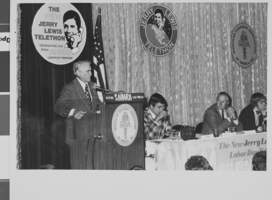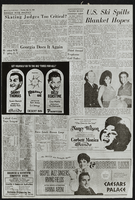Search the Special Collections and Archives Portal
Search Results
Janet Savalli oral history interview
Identifier
Abstract
Oral history interview with Janet Savalli conducted by Irene Rostine on September 21, 1996 for the Women's Research Institute of Nevada (WRIN) Las Vegas Women Oral History Project. Savalli begins her interview by discussing her move to Las Vegas, Nevada as a child in 1945. Savalli then goes on to discuss her 46 year long career at the Southern Nevada Telephone Company. She describes rising through the company starting as an operator and ending as a community relations coordinator. Savalli discusses the company's merger with Sprint and the changes this brought about including the creation of a union and wage and benefits changes. Savalli ends her interview by talking about atomic testing, and how the testing grew to be a part of Las Vegas culture at the time.
Archival Collection
Joanne Pattiani Molen oral history interview
Identifier
Abstract
Oral history interview with Joanne Pattiani Molen conducted by Irene Rostine on January 25, 1997 for the Women's Research Institute of Nevada (WRIN) Las Vegas Women Oral History Project. Molen discusses moving to Las Vegas, Nevada with her husband. She then describes her first telecommunications job working for Citizen Utilities where she learned to operate telephone and faced gender discrimination and wage inequality. Molen explains how that job helped her career with the Southern Nevada Telephone Company. Finally, she discusses the transformation of the telecommunication industry and her community activism in veterans organizations.
Archival Collection
Mary Louise Williams oral history interview
Identifier
Abstract
Oral history interview with Mary Louise Williams conducted by Claytee D. White on June 19, 1998 for the Women's Research Institute of Nevada (WRIN) Las Vegas Women Oral History Project. In this interview Mary Louise Williams discusses her dance career, working at the Moulin Rouge Hotel and Casino, visiting Las Vegas, Nevada numerous times throughout her life, and why she retired in Las Vegas.
Archival Collection
William J. Moore Jr. Photograph Collection
Identifier
Abstract
The William J. Moore Jr. Photograph Collection (approximately 1942-1960) consists of black-and-white photographic prints, negatives, and one oversize image depicting William "Bill" J. Moore Jr.'s career as a casino operator in Las Vegas, Nevada. Images include events at the Moore family home and the Hotel Last Frontier. Also included are images of Moore with politicians, casino operators, and other notable figures in Las Vegas.
Archival Collection
Frank F. Watts Photograph Collection
Identifier
Abstract
The Frank F. Watts Photograph Collection (approximately 1940-1959) contains black-and-white photographic prints, negatives, and slides. The photographs were taken in and around the El Rancho Vegas Hotel and Casino in Las Vegas, Nevada and include publicity photographs, celebrity images, wedding photographs, and images of the hotel interior and exterior. Also included are images of the El Rancho's executives with national figures, including Eleanor Roosevelt and Walter Winchell. A few additional images depict the Hoover Dam (Boulder Dam) and Lake Mead.
Archival Collection
Jillian Hrushowy oral history interviews
Identifier
Abstract
Oral history interviews with Jillian Hrushowy conducted by Joyce Marshall on October 11, 1995 and October 26, 1995 for the Women's Research Institute of Nevada (WRIN) Las Vegas Women Oral History Project. In this interview, Hrushowy describes her dance career, which started in Paris, France. Hrushowy then goes on to describe how her career moved her to Las Vegas, Nevada and the shows she performed in. Further, Hrushowy describes her performance schedule and experiences as a young dancer. Lastly Hrushowy discusses recreation activities in Las Vegas in the 1960s and 1970s.
Archival Collection

Photograph of Mayor Oran K, Gragson speaking at the pre-telethon production meeting, Las Vegas, Nevada, 1974
Date
Archival Collection
Description
Image

Andre King oral history interview: transcript
Date
Archival Collection
Description
Oral history interview with Andre "Brother Dre" King conducted by Claytee D. White on July 20, 2018 for the Remembering 1 October Oral History Project. In this interview, King recalls learning judo and wrestling at an early age. After spending ten years in prison for a burglary offense, he served an additional eleven years in facilities across the state. After twenty-one years in the system, King is now a nondenominational spiritual being and once he learned about the Healing Garden for 1 October victims, he went there daily, during and immediately after the construction. King has helped many survivors and has healed himself as well, through giving love, hugs, and spiritual inspiration.
Text

Transcript of interview with Elmer Hilsinger by Irene Rostine, October 2, 1991
Date
Archival Collection
Description
When Mr. Elmer Hilsinger arrived from the Los Angeles area in 1942, to work as a Refractory Inspector in the Engineering Department at Basic Magnesium Incorporated (BMI), little did he know the town site would grow to be known as Henderson, Nevadain a few short decades. Mr. Hilsinger’s oral history provides a glimpse of the work being done by women at BMI, including women working as chemists, truck drivers, and secretaries. His words attest to the strong work ethic demonstrated by women at the plant during the “war work” period. Through Mr. Hilsinger’s story, we are also provided with an account of what daily life was like for a married couple, including Mr. Hilsinger’s life with his wife who worked as a waitress at Anderson Camp. In addition, Mr. Hilsinger’s oral history touches on the evolution of safety rules within the plant, the transition from the American Federation of Labor Union to the Congress of Industrial Organizations Union, and the role prostitution played during the tim
Text

